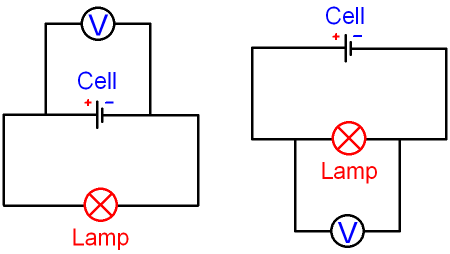
gcsescience.com 5 gcsescience.com
What is Potential Difference or Voltage?
Potential difference
(or p.d.) is another word for voltage.
You can use either term to mean the same thing but most
exam questions use potential difference rather than
voltage.
The potential difference
(voltage) of a power supply is
an
electrical pressure that causes a current
to flow
in a circuit.
Doubling
the supply voltage will double
the current.
What is a Volt?
The power
supply (the cell or battery) gives an amount
of energy to each coulomb of charge
in an electric circuit.
Energy is measured in
joules.
A 6 volt
cell gives 6 joules of energy to
each coulomb.
1 volt = 1 joule per coulomb.
The word "per" means "divided
by",
so voltage = energy ÷
charge.
This equation
can be
rearranged to give
energy = voltage x
charge. E = V x
Q.
Since Q =
I x t,
if we write I x t
instead of Q
in the above equation we get
E = V x I
x t.
energy = voltage x current
x time.
We can also use the word work
instead of the word energy
because work done
= energy transferred
so you might see the equation
energy = voltage x
charge E = V x
Q
written as
work
= voltage x charge W
= V x
Q
See all equations for electricity.
How is Potential Difference measured?
Potential difference is measured using a voltmeter.

The circuit on the left shows the potential difference of the cell.
This is called the supply
voltage. The circuit symbol
for a voltmeter is a circle with the letter
V inside.
A voltmeter is always connected
in parallel with a component.
The voltmeter is said to be connected
across a component.
We use the word "across" to mean
"in parallel with".
The circuit on the right
has the voltmeter connected across
a lamp. This will tell you how many joules of
energy are being
transferred from electrical energy into
light energy (+ heat)
for each coulomb of
charge
that passes through the lamp.
A reading of 6 volts tells you that 6 joules of energy are
being transferred for each coulomb passing through the
lamp.
A reading of 10 volts tells you that 10 joules of energy are
being transferred for each coulomb passing through the
lamp.
![]() Links
Electricity
Revision Questions
Links
Electricity
Revision Questions
![]()
gcsescience.com Physics Quiz Index Electricity Quiz gcsescience.com
Home GCSE Chemistry GCSE Physics
Copyright © 2015 gcsescience.com. All Rights Reserved.